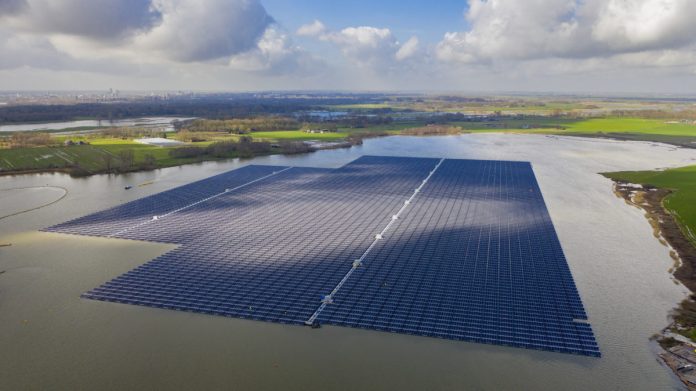“Everything went very quickly,” says Baywa re’s Benoît Roux, when discussing the German developer’s move into the floating solar market.
Baywa entered the specialist field with the acquisition of Dutch developer GroenLeven in 2018, says Roux, director of solar activities for Baywa re in France. GroenLeven had a big plant portfolio, with some projects at an advanced stage of development. “Some plants had to be built very quickly,” Roux tells pv magazine.
Roux and his team surveyed the technical solutions available for floating solar arrays but found nothing which perfectly matched the developer’s requirements. “This is why our teams started to develop, from a blank sheet of paper, a new floating photovoltaic system with [the] support of a network of industrial partners with which we had long years of cooperation, especially on ground-mounted [solar] projects,” adds Roux.
Proprietary tech
Roux highlighted concerns associated with stability, anchoring and the electrical architecture of the floating solar arrays which were being deployed when Baywa entered the field. “The overall organization of the systems did not allow for real optimization of construction costs,” he says.
The result was a bespoke solution which sees Baywa floating solar installations feature a smaller number of floats per panel. Connected by a metal structure, the floats are also larger and more widely spaced from each other, giving Baywa systems greater stability, according to the company.
The modules on Baywa re floating projects have an east-west orientation and are inclined at 12 degrees, explains Roux, who says the set-up offers advantages over south-facing systems.
Benefits
“The shading effects of one panel on the other are reduced, which allows [for] more power [from] the same surface,” says Roux. That adds up to 1.5 MW of generation capacity per hectare for Baywa re systems, compared to 1 MW per hectare for rival solutions, according to the company.
The Baywa set-up also offers greater stability and wind resistance, according to Roux, as there is very little space under the system where wind can rush, avoiding detachment effects. That means strong winds in Western Europe press the solar structure onto the surface of the water rather than lifting it. Another advantage offered by the Baywa inclination angle is better anchor control. “The specific east-west orientation allows us to optimize the size of the anchors, and therefore the costs,” adds Roux.
The Baywa re technology – which received a pv magazine top innovation award in March – also limits the impact on underwater flora and fauna.
“The water coverage is reduced as the floats are more spaced,” says Roux. “This is important, to allow better circulation of water and avoid standing water between the floats. It also prevents the development of algae, which could upset the balance of the surrounding ecosystem.” That spacing of the floats also enables better penetration of air into water under the panels, adds Roux, as well as limiting evaporation. “The first studies carried out on this subject estimate that the water lost by evaporation when the basin is covered by such a system, is almost 70%,” says the Baywa re representative.
50 MW in a year
Over the past two years, Baywa has installed several projects in the Netherlands: from a 2 MW pilot facility at Weperpolder to the nation’s largest floating solar plant to date, the 27.4 MW Bomhofsplas installation. The German company has also achieved record construction times: only six weeks to build the 14.5 MW Sekdoorn power plant, and seven weeks for Bomhofsplas.
“We have a very optimized mounting system,” says Roux. “The ‘boat’ systems, with four floats linked by a metal structure, are assembled with a chain to a platform on the shore of the lake. All these boats are then assembled together, then slid into the water and brought to the intended place in the water by simply being towed by a few zodiacs [inflatable dinghies]. Our latest, 27.4 MW project at Bomhofsplas, had to face storms during construction and everything went very well, as evidenced by the speed of completion of this park.”
Lower costs
Baywa president Benedikt Ortmann in November described floating solar as still a niche sector, with costs 20-25% higher than those of conventional, ground-mounted PV projects. “However, having already installed 50 MW we have seen fairly spectacular cost reductions, particularly in construction costs,” says Roux. “When we have installed 100 MW, 500 MW or even when we have surpassed the gigawatt bar, we will have even more significant gains in scale. They will allow us to reach a level of competitiveness comparable to other technologies that we are deploying today more massively, in France in particular.”
Baywa said it is already competitive on 20 MW-plus, large floating projects, particularly in southern latitudes. The levelized cost of energy produced by such arrays is expected to fall further in the next 2-3 years, as economies of scale are realized.
“In France, there is … very interesting potential for floating photovoltaics,” says Roux, of a technology which can be deployed at scale on man-made bodies of water, especially in countries lacking land for conventional solar.
Baywa re plans to install an additional 100 MW of floating solar in the Netherlands this year, with a 40 MW plant expected to start construction in the coming months in the northern province of Drenthe. The developer’s floating solar installations would then add up to 150 MW.






